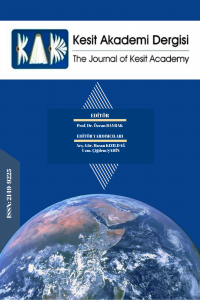DÖVME, PİERCİNG GİBİ BEDEN UYGULAMALARININ GERİSİNDEKİ GÜDÜLENME
Çalışmanın amacı, dövme ve piercing gibi beden uygulamalarının ardındaki güdülenmeyi psikolojik ve psikanalitik açıdan ele almaktır. Bu bağlamda, bireyleri çeşitli beden uygulamalarına yönelten değişik faktörler üzerinde durulmuştur. Estetik kaygılar, özel ve farklı olma isteği, güç gösterme ve protest tutumlar, haz ve cinsel amaçlı uygulamalar, kültür, kimlik, aidiyet, din ve sosyal statünün gösterilmesi metinde değinilen psikolojik etmenlerdir. Belirtilenlere ek olarak, beden uygulamalarının psikanalitik anlamları üzerinde durulmuş ve bu pratiklerin sembolik anlamları belirtilmiştir. Bu hususta, dövme, piercing ve kasti yara izi oluşturma gibi bedene yönelik uygulamaların yeniden doğumu çağrıştırdığı ve bu yolla kişilerin ikinci bir ten doğurarak ona bakım verme pratiklerinden bahsedilmiştir. Ayrıca yas durumlarında yitirilen nesneyle bağlantı kurma maksatlı uygulamalar olabileceği ve bunun bir baş etme olarak yorumlanabileceği belirtilmiştir.
Anahtar Kelimeler:
dövme, piercing, psikoloji, psikanaliz, beden uygulamaları, sembolik anlam
PSYCHOLOGICAL MOTIVATIONS BEHIND TATTOO AND PIERCING
The aim of the current study was to conceptualize the underlying psychological and psychoanalytical motivations behind tattoo and piercing type of implementations on skin. Therefore, different factors motivating individuals to apply tattoo or piercing on their skin were discussed. In this sense, aesthetic concerns, desire of being different and special, exhibiting physical strength and protest attitudes, having pleasure and sexual objectives, demonstrating culture, religion, identity, social status and belongingness were referred as being underlying psychological dimensions. Besides the mentioned factors, psychoanalytical and symbolic meanings of the mentioned skin implementations were highlighted. Thus, symbolic rebirth associative meaning of tattoo, piercing and scarification was mentioned. Through giving symbolic birth to the second skin, individuals experience themselves as a newborn individual as well as take care of themselves as if looking after a newborn baby. Additionally, in bereavement phases, individuals’ tendency to have skin implementations to form a symbolic connection with the lost object was considered as a coping mechanism.
Keywords:
tattoo, piercing, psychology, psychoanalysis, skin implementations, symbolic meaning,
___
- Anzieu, D. (2018). The skin-ego: A new translation by Naomi Segal. Routledge.
- Armstrong, M. L., Caliendo, C., & Roberts, A. E. (2006). Genital piercings: What is known and what people with genital piercings tell us. Urologic Nursing, 26, 173-180.
- Atkinson, M. (2002). Pretty in ink: Conformity, resistance, and negotiation in women’s tattoo- ing. Sex Roles, 47, 219-235.
- Bick, E. (1968) The Experience of the Skin in Early Object Relations. International Journal of Psychoanalysis 49: 558- 566.
- Çağlayandereli, M., Göker, H. (2016). Anadolu dövme sanatı; Tunceli ili örneği. Journal of Human Sciences, 13(2), 2545-2562. doi:10.14687/jhs.v13i2.3827.
- Delazar, M. E. (2005). The relationship between self-esteem, objectified body consciousness, personality traits and body modification: An exploratory study. (unpublished) PhD thesis, Indiana University Pennsylvania, USA. Dissertation Abstracts International: Section B: The Sciences and Engineering, 65, 5395.
- DeMello, M. (2000). Bodies of inscription: A cultural history of the modern tattoo community. Duke University Press: Durham.
- Ertan., C. (2013). Kültürel bir ifade aracı olarak dövme ve farklı toplumsal bağlamlardaki gö- rünümleri. Uluslararası katılımlı 7. Ulusal Sosyoloji Kongresi Bildiri Kitabı. (Ed:M. Tuna) Muğla:189-199.
- Favazza, A.R. (1998). The coming of age of self-mutilation. The Journal of Nervous Mental Di- sease, 186(5), 259-268.
- Forbes, G.B. (2001). College students with tattoos and piercings: motives, family experiences, personality factors, and perception by others. Psychological Reports. 89: 774-796.
- Hewitt, K. (1997). Mutilating the body: Identity in blood and ink. Popular Press.
- Lemma, A. (2010). Under the skin: A psychoanalytic study of body modification. Routledge.
- Mifflin, M. (1997). Bodies of subversion: A secret history of women and tattooing. New York: Juno.
- Pitts, V. (2003). In the flesh: The cultural politics of body modification. Springer.
- Quaranta, A., Napoli, C., Fasano, F., Montagna, C., Caggiano, G., Montagna, M.T. (2011). Body piercing and tattoos: a survey on young adults’ knowledge of the risks and practices in body art. BMC Public Health, 11:774. Doi: 10.1186/1471-2458-11-774
- Selvin, E. The Aesthetics of Tattoo & Body Modification.
- Stirn, A. (2003). Kunstvolles Ta¨towieren und Piercing als selbstfu¨ rsorgliche Handlung trau- matisierter Menschen [Artistic tattooing and piercing as self-caring act of traumatized people]. Psychoanalyse – Texte zur Sozialforschung, 12, 48–59.
- Stirn, A. (2004). Die Selbstgestaltung des Ko¨rpers – narzistische Aspekte von Tattoo und Pier- cing [Designing the own body – narcissistic aspects of tattoos and piercings]. Psychot- herapie im Dialog, 3, 256–260.
- Yücel, Ö.D., Çevik, A. (2015). Kimlik ifadesi olarak dövme . Kriz Dergisi 23 (1-2-3): 17-26 . http://dergiler.ankara.edu.tr/dergiler/21/2189/22681.pdf
- Wohlrab, S., Stahl, J., Kappeler, P.M. (2007). Modifying the body: Motivations for getting tat- tooed and pierced. Body Image, 4, 87-95.
- www.benibuldular.com/ Erişim Tarihi: 26.02.2017.
- www.canergz.com/tendeki-desen-dovme. Erişim Tarihi: 26.02.2017.
- www.nationalgeographic.com.tr/makale/subat_2015/dovme-tendeki-desen/2391.Dövme: Ten- deki desen National Geographic Türkiye, Şubat 2015, 166, 32-55, İstanbul: Doğuş Der- gi Grubu. Erişim Tarihi: 26.02.2017.
- Başlangıç: 2015
- Yayıncı: Asos Eğitim Bilişim Danışmanlık San. Tic. Ltd. Şti.
Sayıdaki Diğer Makaleler
Aisha Merghanı Abd Elrahıem SOLYMAN
داللة ، اختيار ، لفظة ، مغايرة ، سمو
Kawther Elshafıe Mohamed AHMED
DİN BİLİMLERİNDE ANTROPOLOJİK YAKLAŞIM VE DİN- KÜLTÜR/ MEDENİYET İLİŞKİSİ
DİNİ HÜKÜMLERİN GENEL GAYELERİNİN CEZA HUKUKU İLE İLİŞKİSİ
TÜRK İNANÇ VE SANATINDA GÖK CİSİMLERİ
MİLLİ MÜCADELE’DE İNGİLTERE’NİN KÜRT POLİTİKASI VE BİNBAŞI NOEL
DÖVME, PİERCİNG GİBİ BEDEN UYGULAMALARININ GERİSİNDEKİ GÜDÜLENME
